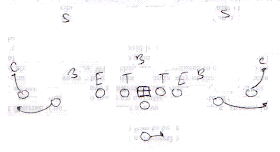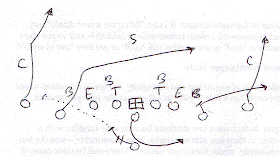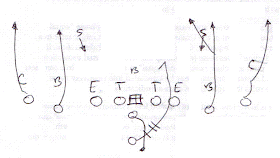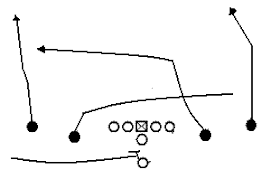
The Ryan Leaf saga has taken its most tragic -- and possibly final -- turn:
CANYON, Texas (AP) -- Former NFL quarterback Ryan Leaf has been indicted by a Randall County grand jury on drug and burglary charges.
The indictment handed up Wednesday in Canyon charged the 33-year-old former San Diego Chargers quarterback and former West Texas A&M quarterbacks coach with one count of burglary to a habitation, seven counts of obtaining a controlled substance by fraud and one count of delivery of a simulated controlled substance.
The indictment said Leaf presented an incomplete medical history to several physicians between January 2008 and September 2008 to get or try to obtain the painkiller Hydrocodone. . . .
Canyon police Lt. Dale Davis said Leaf is suspected of breaking into a Canyon apartment on Oct. 30 and stealing Hydrocodone, which had been prescribed to an injured football player. . . .
"We have not found any evidence implicating anyone other than Mr. Leaf in this case ... but believe there's additional evidence implicating him in other events," [Randall County district attorney James] Farren said. He would not elaborate.
(H/t Dr Saturday.) Leaf of course was a world-class bust in the NFL, as much for personality reasons as for physical ones. But in college, he was a beast: He led Washington State to a 10-2 record and a Rose Bowl appearance, he threw for 3637 yards (over 330 a game), and 33 touchdowns. (Team stats here.)
And, particularly in historical perspective, that Washington State offense was dynamic. Mike Price designed it based on, in part, by what he had learned from Dennis Erickson's one-back attack at Washing State and elsewhere. Indeed, this one-back offense was one of the predecessors for the modern spread attack, both in terms for passing and running. Mike Leach and Hal Mumme visited Price to learn his offense before they went on to break every SEC passing record in 1998, and Price shared his offense's precepts with coaches like Purdue's Joe Tiller, who had also worked with both Price and Erickson.
Price, of course, experienced his own rise and fall. He was hired to coach at Alabama and, after some kind of stripper-scandal (aren't all the best scandals stripper-related?), was fired before his first season could even commence.
But, for a time, especially in 1997, the two, Leaf and Price, coach and quarterback, combined to put on a show worthy of the sliver of immortality reserved for all such successful seasons. In this post I will give a brief overview of the theory behind the Washington State offense that year. Mike Price liked to joke that he could explain it in five minutes on the back of a napkin. An exaggeration, but not much of one.
The Washington State one-back
Price employed a lot of formations that year, but they used the "double slot" the most: two receivers to either side of the quarterback along with one running back. Many now will recognize this as the basic spread formation (though Leaf was usually under center rather than in the shotgun), but back then it was somewhat of a novelty still. Price used it because of its then relative rarity, but also for practical reasons: Washington State's fourth wide receiver was better than its tight-end.
The basic theory behind the offense is the one that has been adopted by almost all spread teams: count the safeties, identify how many defenders are in the "box" to decide whether to run or pass, and call your bread and butter stuff until defenders get of of position, then when they do hit them with the constraint plays like bubble screens or play-action. As my article on Urban Meyer's offense explains, Meyer's offense follows the same basic pattern.
To begin with, assume the defense has just one safety back. That means that, if they cover all the receivers, the defense has only six guys in the "box" -- i.e. the interior defenders. The offense has only five blockers, and Leaf was not much of a threat to run. They did however have good matchups on the outside. So the first thing WSU looked for was the leverage of the cornerbacks: were they playing soft or tight? If they played soft, Price (or Leaf via audible) would call a quick, five-yard hitch to the outside receivers. Leaf needed only to pick the best matchup and fire the ball out there. Let the receiver catch a quick one, make a defender miss, and make a big play.

If the defense played "tight," however, Price and co. dialed up one of their "option routes." The outside receivers were to run deep and try to get open deep (which happened with some regularity, as the highlight against UCLA above showed). The inside receivers were to burst upfield to eight to twelve yards depending on the call. Against man-to-man, they cut inside or outside depending on the defender's leverage; against zone they found a hole between defenders and settled in it.

What if the defense put two safeties back, to guard the deep pass and play the receivers tight? Well, then it only had five in the box, so it was time to run the ball. In 1997, Washington State had a good running back, Michael Black, who ran for over 1100 yards in 11 games.

And that pretty much covers the bases. Where it gets trickier is when defenders try to "cheat" -- and that's when you get into the constraint plays. First, the defense might line up with two safeties back but the outside linebackers over the slot receivers will cheat in to stop the run. In that case, the offense can throw the bubble screen.

Alternatively, the inside linebackers or the outside linebackers might cheat in or be watching the run, so that's when the bootleg is often effective. The quarterback looks to hit either the man in the flat or the slot on the deep crossing route.

Finally, if the safeties want to cheat up, well then it is home run time. The quarterback will fake it to the runningback and run the four-verticals concept or another deep attacking play.

That's really about it. an incredible amount of their offense was spent just cycling between that sequence. And Leaf, at least that year, showed a great propensity to read defenses and make the right read on passing plays. But obviously he was helped by having a smart, simple framework to work from.
Other applications
Of course there are other concepts worth mentioning briefly. One was Price's version (or one of his versions) of the shallow cross. Price combines the shallow with the deep cross. The quarterback reads the play by first looking at his deep routes as his "peek" or "alerts" -- i.e. if the home-run is there, take it. If the go and the post aren't open, the shallow cross is "hot," against a blitz, otherwise he can read the deep-cross as his "high" read and the runningback as his "low" read. See the diagram below.

And you can see Leaf hit the deep-cross or "hunt" player against Michigan in the Rose Bowl, with heavy pressure in his face.
And another nice route is what Spurrier called the "Mills" play. It is designed to either be a simple curl-flat read, but with a post route over the top of it. In a lot of coverages -- especially four-deep across -- the safeties play very aggressive, and will jump routes in front of them. This gives the play its big-play potential: if the safety jumps the curl, the post route is wide open behind the defense . . .

. . . and that is exactly what happened in 2002 when Washington State played Pete Carrol's Southern Cal team. (Washington State upset USC, led by Carson Palmer, and probably cost them a shot at the national title game. WSU's quarterback was Jason Gesser, though Price was still the coach.) See the video below.
Conclusion
Exceedingly simple, but those were the spread's gestative years. Maybe history would be different had Price managed to stick around at Alabama, and brought his unique one-back to the SEC before Meyer had set foot in Gainesville. (Though Price's subsequent years at UTEP haven't been spectacular.)
But the larger point is that football, especially in modern times, offers some degree of immortality for those who succeed. Leaf's more recent infamy as NFL bust and low-level criminal will now never leave him, but his full record will always include 1997, when there was no better triggerman in the Pac-10 -- maybe the country. He didn't have an all-star cast around him, just some shifty, tough guys, a well-designed playbook, and the confidence, maybe arrogance, to be great, even if only for a time.
Wow, no wonder why he had so much trouble in the NFL. When most of your reads are pre-snap, it must be a shock to deal with the advanced reads in the league.
ReplyDeletegreatest site is the best blog ever
ReplyDeleteChris: Great memories! Homer Smith covered this in his manual "A History of Football Concepts," telling the story in the process of how eight-man front, "gap control plus" defensive systems were able to dominate two-back offenses, but were in turn dominated by one-back systems like WSU's...
ReplyDeleteThe old WSU one-back alignment is quite similar to the base formation of Paul Johnson's option-based spread/flexbone/double-slot spread at Georgia Tech (and still at Navy, of course). Heaven help the ACC if Tech's passing game even improves to "average" as it also gets better running the ball. (Folks forget that during Paul Johnson's days as an OC at Georgia Southern in the mid-1980s and at Hawaii in the late 80s and early 90s, his offenses earned respectable passing yardage in addition to great rushing yardage.)
ReplyDeleteA minor correction: Wazzu vs. USC in 2002 technically wasn't an upset, since Washington State actually was ranked higher in the AP than USC (#20 vs. #18) and since the game occurred before USC entrenched itself as the megalodon of the Pac-10 (the previous season yielding a measly 5-7 record).
ReplyDeleteChris, a little nitpicking, but Spurrier did not call that combination "Mills." Mills was basically the same thing, except the curl was a dig.
ReplyDeleteTremendous blog.
Leaf has a scheme that wasn't really widespread at the level he played, and it kept him ahead of the competition.
ReplyDeleteThe NFL changed it because he had tighter windows to throw off press coverage.
Manning in the same draft, with a bevy of all world speed on the Vols.